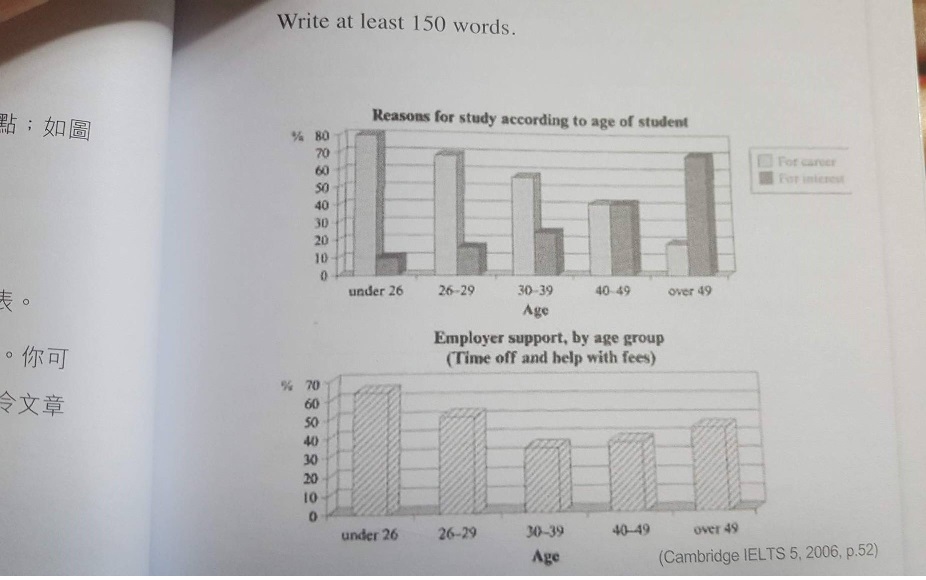The charts below show the main reasons for study among students of different age groups and the amount of support they received from employers.
Summarise the information by selecting and reporting the main features, and make comparisons where relevant.
Write at least 150 words.
The first bar chart illustrates the motivations for students in various age classes to study while the second one provides information about support offered by employers across different ages.
In general, young students tended to learn for career whereas older students pursued studies for the sake of interest. In addition, employers preferred to support students who were under 26 years old.
It is apparent that career is a critical driving factor for students under 40 years old to study. There were almost 80% and around 70% of students aged below 26 and 26 to 29 respectively admitted that career was the reason for them to have higher education qualification. Even though the figure of age group 30 to 39 was lower, the share of people in this group agreed with studying for career still exceeded the half of total portion of this group. In contrast, less than one third of respondents claimed that their own interest encouraged them to study further. The situation reversed at the group of 40 to 49 in which the number of interviewees claims they learnt for career and interest which were the same were 40%. In the group of over 49, more than two thirds of respondents stated that interest was their stimulus to study.
As for support from employer, the age group of below 26 was most likely to receive support from their employers. Over 60% of students aged lower than 26 were supported by employers. However, students aged 30 to 39 had the lowest probability to receive help which was about one third of total. This figures increased slightly for students in their forties and above. (273 words)
Summarise the information by selecting and reporting the main features, and make comparisons where relevant.
Write at least 150 words.
the road from study to work
The first bar chart illustrates the motivations for students in various age classes to study while the second one provides information about support offered by employers across different ages.
In general, young students tended to learn for career whereas older students pursued studies for the sake of interest. In addition, employers preferred to support students who were under 26 years old.
It is apparent that career is a critical driving factor for students under 40 years old to study. There were almost 80% and around 70% of students aged below 26 and 26 to 29 respectively admitted that career was the reason for them to have higher education qualification. Even though the figure of age group 30 to 39 was lower, the share of people in this group agreed with studying for career still exceeded the half of total portion of this group. In contrast, less than one third of respondents claimed that their own interest encouraged them to study further. The situation reversed at the group of 40 to 49 in which the number of interviewees claims they learnt for career and interest which were the same were 40%. In the group of over 49, more than two thirds of respondents stated that interest was their stimulus to study.
As for support from employer, the age group of below 26 was most likely to receive support from their employers. Over 60% of students aged lower than 26 were supported by employers. However, students aged 30 to 39 had the lowest probability to receive help which was about one third of total. This figures increased slightly for students in their forties and above. (273 words)

reference_book_exerc.jpg
